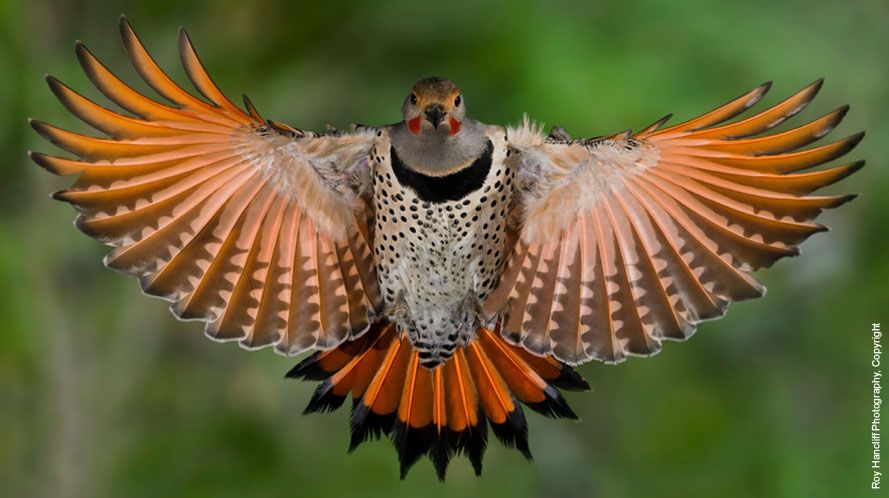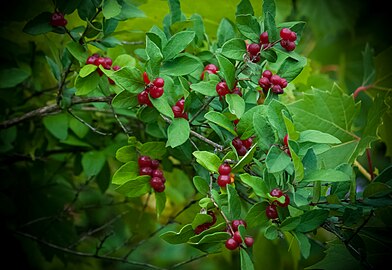Birders
Related: About this forumEasterncedar
(2,298 posts)These birds are gorgeous; a favorite.
Walleye
(31,027 posts)Donkees
(31,409 posts)I have a pair of Northern Flickers visiting the hulled sunflower/peanut feeders, and I do see them during nesting season chasing after the large black ants on the ground near oak trees.
apcalc
(4,465 posts)2naSalit
(86,636 posts)We have them in Montana too but I noticed when I moved to the west that the Northern Flickers in the east have yellow coloring where the ones in the west have red colored plumage.
Donkees
(31,409 posts)
The mystery of the color-changing woodpecker has been solved.
For years, scientists have been confused as to why up to one-third of yellow-shafted northern flickers (Colaptes auratus auratus), a type of relatively common woodpecker, are spotted sporting reddish and orange plumage. A prime theory was to blame it on western red-shafted flickers, which are similar except for their rouge coloration. Indeed, the two subspecies hybridize, or interbreed, where their ranges meet in the western Great Plains and eastern Rockies, creating a zone of intermediate-hued birds, ranging from orange-y to salmon pink. But these strangely colored flickers were found far from this area, in the Northeast and elsewhere along the eastern Seaboard where the western subspecies hadn't been thought to exist. What explains the colorful enigma?
Jocelyn Hudon, the curator of ornithology at the Royal Alberta Museum, hypothesized that the reddish hue was caused by a pigment found in the berries of two types of invasive shrubs, Tartarian and Morrow's honeysuckle, originally imported from central Asia and Japan. Work by Hudon and others including National Aviary ornithologist Robert Mulvihill and Alan Brush, emeritus professor at the University of Connecticut, showed that when birds known as cedar waxwings eat these berries, their feathers can take on an orange cast caused by pigments found therein. This has also been observed in yellow-breasted chats, a species which can turn a bit orange after feasting on honeysuckle, Mulvihill says.
In a study published October 12 in the journal The Auk, Hudon and colleagues discovered that the red coloration is indeed caused by a pigment known as rhodoxanthin, which is found in these exotic honeysuckle berries. This is a different chemical from the substances which are responsible for the prominent coloration in western red-shafted flickers, known as 4-keto-carotenoids. Rhodoxanthin is biochemically similar to chemicals that create yellow coloration, and it gets laid down in its place; and also seems to interfere with the production of the yellow pigments, Hudon says.
The situation is somewhat ironic, Hudon says, considering the honeysuckles were originally widely introduced in the 1960s to create better wildlife habitat. "A species introduced with good intentions is messing up the coloration of birds," Hudon says
https://www.newsweek.com/invasive-berry-turning-birds-feathers-red-509005


Jeffrey Kauffman
2naSalit
(86,636 posts)Didn't know that part or the part about the two subspecies blending where they meet/differentiate geographically.
![]()
erronis
(15,286 posts)Walleye
(31,027 posts)I don’t think I’ve ever seen berries on the honeysuckle vines around here. They seem native like they were always around, when I was growing up. I have seen birds eating the holly berries. And I saw cedar waxwings this week, I think for the first time ever.
Donkees
(31,409 posts)Bo Zarts
(25,397 posts)3Hotdogs
(12,384 posts)all the water in the park is controlled by one faucet.
niyad
(113,322 posts)democrank
(11,095 posts)Thanks for posting this.
Elysium
(41 posts)One of my favorite woodpeckers.

